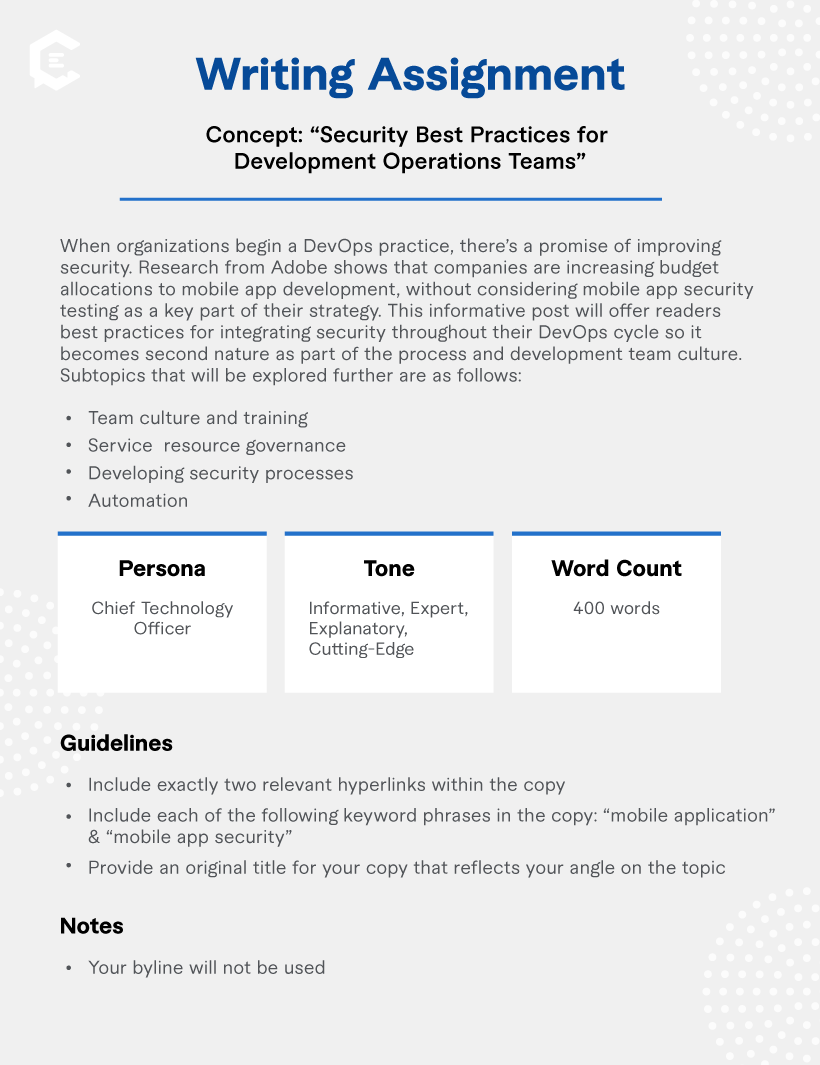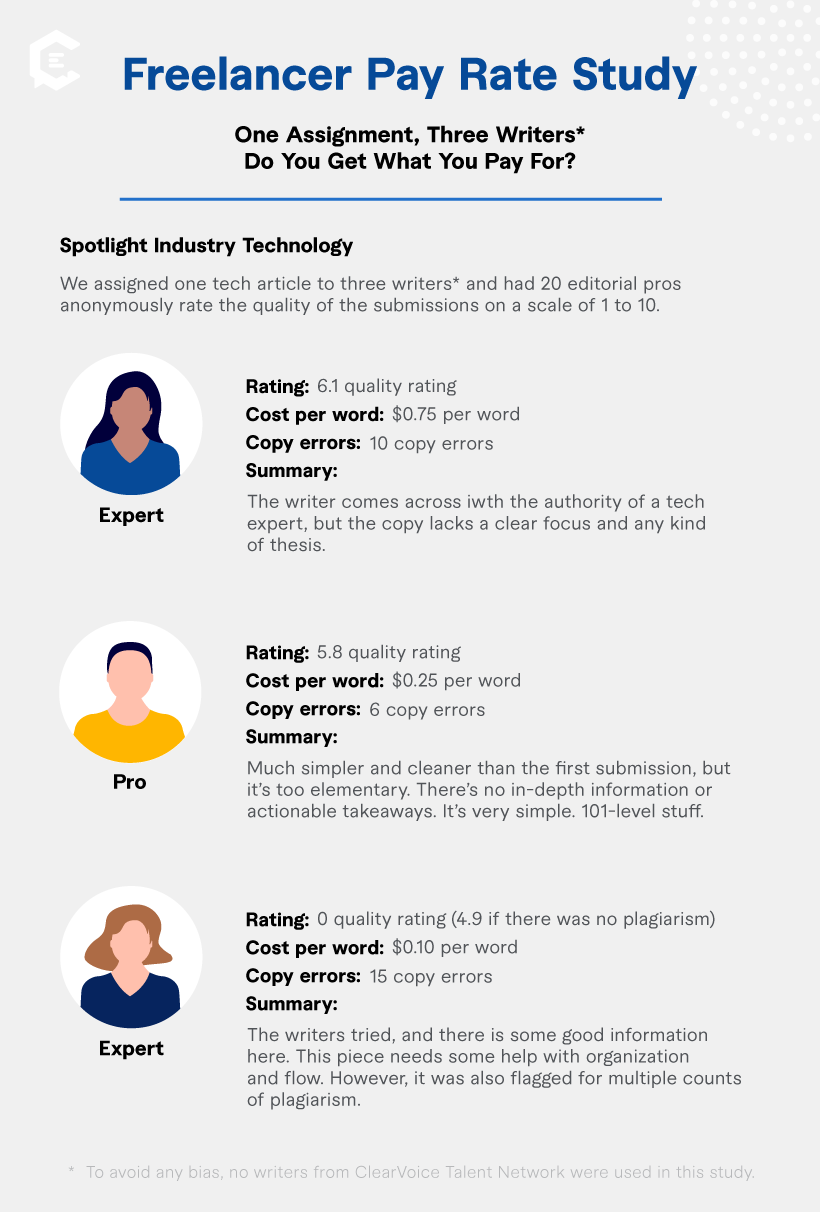Are freelance writers’ rates and quality correlated? Based on experimentation and experience, ClearVoice finds that brands get what they pay for when it comes to freelance talent. High-quality, experienced writers tend to provide a better ROI than less expensive freelance talent.
In America, there are around 137,000 writers, and two-thirds are self-employed individuals, according to the U.S. Bureau of Labor Statistics. Long story short, there isn’t a shortage of freelance writers available for hire. With the explosion of job boards and niche writing gig sites, paired with the growth of the freelance economy, there are countless options for brands to source outsourced writers.
While the general writer pool may be large, technology brands have unique and complex needs that require high-quality content producers. So, after the completion of our previous study at ClearVoice on “The Power of Pay” in travel industry, we conducted another study to determine if freelancer rates and quality are correlated in the technology space. In the previous study, we found that freelancers with higher rates were correlated with higher quality submissions. But, would this be the case in a vastly different industry?
We put tech freelance writer rates to the test… Three writers were assigned the same story, a 400-word post about “Security Best Practices for Development Operations Teams.” Twenty editorial pros from around the country rated the quality of each submission.
Hypothesis
Similar to the hypothesis of our previous travel writer study, we predicted this study’s findings would reveal that freelance tech writers’ pay rate (cost per word) and editorial quality are highly correlated.
Methodology
To put our hypothesis to the test, we evaluated three technology writers, at three different pay-rate levels. The writers’ pay rates were the following:
- Beginner: $0.10 per word ($40)
- Pro: $0.25 per word ($100)
- Expert: $0.75 per word ($300)
We chose writers from various sources, and, to avoid bias, avoided using writers from our ClearVoice Talent Network. The expert writer was chosen as a personal referral, having experience at multiple SaaS companies, and is a speaker at marketing tech conferences. The intermediate-level writer came to us as a referral, with around five years of experience as a writer. The beginner-level writer was selected from a job board based on a pitch sent. (They had the most compelling bio and pitch of the 15 applicants.)
After the writers were selected, we sent the following assignment guidelines. Writers had one week to complete the assignment, and were never told that this was part of a study. Here were the assignment details:
Judging
After each writer’s submission was received, 20 editorial professionals judged the quality of the work on a sliding scale from 1 to 10, with 1 being “Horrible” and 10 being “Perfect.” Each submission was judged anonymously, without any indication of the writer’s name or pay rate. The editorial panel was asked to “rate the overall quality of each submission” based on:
- Grammar and degree of copy editing needed
- Sentence variety and lack of filler
- Readability and logical story structure
- Factual accuracy and specific details
- Trustworthiness and authenticity
- Ability to follow assignment directions, including third-party source inclusion and attribution
- Ability to meet the deadline
- Overall quality of writing
In addition, the editorial experts were prompted to include editorial critiques and feedback.
Our Findings
Our hypothesis was accurate: Even in a different industry from our original test (travel), we found that quality and writer pay is correlated. Again, it should come as little surprise that a higher price per word attracts more capable, higher quality, and perhaps more reliable freelance writers.
Our findings confirm that the expert at the highest pay rate, at $0.75 per word, showed significantly higher quality, and was rated 6.1 out of 10. The mid-level pro, who charged $0.25 per word, was rated 5.8 out of 10; and the beginner writer, with a cost per word of $0.10, was rated 4.9 of 10.
Unlike the travel study, the expert and pro writers were neck and neck. The top submission (expert) was overall very editable and the author demonstrated a good, natural knowledge of the subject matter. The expert’s submission also got a lot of praise for following editorial direction. The main criticism for the pro was that it could have been 201-level knowledge, versus the basics. The beginner’s submission was not horrible, but had the most errors and was likely not a native English speaker. Oh, wait, and three instances of plagiarism flagged by Copyscape, which resulted in an automatic 0.
BY THE NUMBERS: AVERAGE RATING
- Expert: 6.1
- Pro: 5.8
- Beginner: 0 (4.9 if not disqualified for plagiarism)
Let’s explore the submissions in greater detail…
Expert
- Rating: The expert submission was rated 6.1, on average.
- Grammatical errors: 2
- Factual errors: 1
- Spelling errors: 0
- Word usage errors: 3
- Other edits required: 4
- TOTAL ERRORS: 10
Additional Feedback:
- The submission was written in a very clean, journalistic manner.
- The submission clearly presented details.
- One expert editor remarked, “It would take a little editing, but this writer comes off as very editable, and I like how they made the concept and subtopics their own, while executing well on what was requested for the most part.”
- Multiple editorial experts surveyed liked the introductory paragraph, which offered a metaphorical lead.
Pro
- Rating: The average rating was 5.8.
- Grammatical errors: 1
- Factual errors: 0
- Spelling errors: 0
- Word usage errors: 2
- Other edits required: 3
- TOTAL ERRORS: 6
Additional Feedback:
- This article is easy to read, straightforward, and well formatted.
- This writer followed instructions very well, with a proper number of words, links, and covered exactly the topics desired.
- While the submission followed editorial directions of including keywords, it had overly “amateurish keyword stuffing.”
- It’s much simpler and cleaner than the first submission, but it’s too elementary. There’s no in-depth information or actionable takeaways. It’s very simple, 101-level stuff.
Beginner
- Rating: The final rating for beginner writer was 0. The post was disqualified due to multiple instances of plagiarism. If not plagiarized, its rating would have been 4.9.
- Grammatical errors: 4
- Factual errors: 0
- Spelling errors: 0
- Word usage errors: 0
- Other edits required: 15 (Including three instances of plagiarism.)
- TOTAL ERRORS: 19
Additional Feedback:
- This writer tried, and there is some good information here. This piece needs some solid help with organization and flow, and the writer should have proofread their work – there are several tiny, sloppy edits. And of course, some Copyscape issues.
- The submission didn’t follow the directions of keyword use, and only provided one hyperlink to an external source.
- While the submission was technically advanced (the author had a good sense of technical operations), the article still requires extensive editing.
- The submission lacked structure and scannability.
- The grammar and flow are off in several places. It feels like it was written by someone who does not speak English as their primary language.
Action Items for YOU
As a brand marketer, remember this: High-quality, more expensive writers offer a better ROI for your business. This is true because:
- As a busy marketer, hiring an expert-level tech writer eliminates long editing times and the headache of having to coach novice writers.
- Expertise in the tech field is key. This is not a “fake it until you make it” field. Readers can spot a phony writer in seconds, which reduces your credibility as a company and ability to convert readers into customers.
- Plagiarism issues are no joke. Hiring high-quality writers can eliminate the chance of hiring a plagiarist, and also allows you to save more time. Many brand marketers will have to edit the writer’s work to make it original, further wasting precious time.
- Hiring good writers is good for your bottom line. High-quality web content leads to improved online visibility, better lead generation, and higher conversions.
- Hiring freelancers is almost always cheaper than hiring a traditional employee. Even if a freelancer’s rate is high, you’re not on the hook for providing benefits or long-term employment.
So, if you’re looking to find high-quality freelance writers, first develop editorial guidelines and campaign parameters so writers have a clear understanding of what’s demanded of them. Then, find the right channels to find high quality writers. (Shameless plug: You can get matched with writers in the ClearVoice Talent Network.) And, if they are good… Keep and reward them.)
If You’re a Tech Freelancer…
As a freelance writer specializing in the tech industry, choose your rate (whether per word, hour, or project) based on level of expertise, years of experience, and industry standards. (Here are freelance writing rates and industry averages.) If you have two years of experience as a writer and no experience writing for tech clients, you do not have the authority to charge $0.75 to $1.00 per word. Instead, start at $0.10 per word, and work your way up as you develop expertise in this field. Offer great writing samples or create an online portfolio to show brands your expertise.
And the Top Submission Was…
Although we won’t post all the submitted articles, we thought we’d at least share the one that received the highest overall quality rating. Note: This is raw, unedited copy. Editors out there, please chill. No trollin’. 🙂
Synchronizing Development Operations for Increased Security
Rowing crew has more in common with software development than one might originally think. There is a palpable heartbeat to the oars hitting the water in crisp, synchronized sweeps. The more in sync the crew members are, the more effective their race.
Synchronization is just as critical to the development and operations teams within your company as it is to a competitive boat race. A kink in the chain can snowball into expensive delays in application launches—or worse—potential breaches in security.
As stated by Marc Andreesson, “software is eating the word.” Businesses of all shapes and sizes are developing their own software for mobile application and subscription services. However, research from Adobe indicates that while budgets for software development are increasing, security testing is not always a significant part of the development process.
Prioritizing Resources for DevOps
The most effective strategy for integrating your software team is an Agile or DevOps approach. DevOps implementation spans three factors of your business: people, processes, and tools—synchronizing your team and prioritizing security. A critical component of the DevOps philosophy is breaking down the silos between the development and operations teams to improve consistency and streamline an automated process.
Instilling Agile and DevOps in Your Culture
Implementing an Agile, DevOps strategy will improve the outputs of your team; but instilling it in the fabric of your culture will ensure a more cautious approach to security. This is becoming ever more critical as the market for mobile applications grows and becomes a more attractive target. The earlier Agile principles are practiced, the more in sync your team will be, and the more effective they will be at managing development and handling issues as they arise.
Investing early in DevOps will prepare your team for entering the trenches. They will have time to create that heartbeat, allowing them to mitigate risk, and respond swiftly to bugs and issues.
There are three critical steps to inoculating a new business practice such as DevOps into your culture:
- Survey your team to develop an understanding of the existing culture.
- Communicate your intentions through a presentation of your vision.
- Reward employees for cohesion and teamwork.
Developing Processes for Mobile App Security
Once you have alignment across teams, you will be able to prioritize processes for increased security. To ensure effectiveness, mobile app security should be factored into each stage of the development lifecycle:
- Design and build the product with consideration of all compliance and privacy requirements.
- Utilize multiple testing protocols and secure component lifecycle management.
- Fix any vulnerabilities as they arise throughout the development process.
- Insist on metrics and reporting to ensure secure SLDC practices and risk management.
- Automate the practices through repetition.
Protecting Your Organization
The Ponemon Institute and IBM identified the average cost of a single data breach at $3.79 million. These breaches should not be taken lightly. Planning ahead and creating a culture that lives and breathes DevOps will improve your mobile app security by synchronizing development and execution toward that common goal.
We assigned one travel article to seven writers and had 30 editorial pros rate the quality of the submissions. Did vetted experts outperform less experienced writers? See the results.





